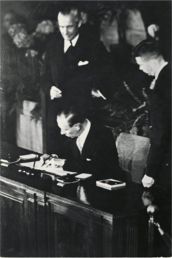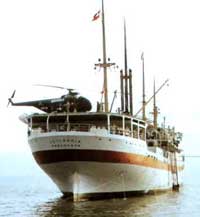|
You are here: 4Campaigns & Battles4Index4The Navy 1945-1989 |
||||||||||||||||||||||||||||||||||||||||||
|
The Navy (1945-1989):
A sad sight met Danish naval personnel, when
they once again took possession of Holmen in May of 1945. Here – Danish wrecks
fill the Søminegraven, one of the many channels running through the base.
The post-war Period
|
|||||||||||||||||||||||||||||||||||||||||
|
Denmark's Secretary of State, |
UN and NATO membership for Denmark As early as October 24, 1945, Denmark became a member of the UN, which had succeeded the defunct League of Nations. In addition, discussion of other defense constellations took place. Among others, the possibility of establishing a joint Nordic defense cooperation. The plans for joint Nordic defense cooperation, however, did not work out. Instead, Denmark, together with Norway, joined The North Atlantic Treaty Organization, NATO, in 1949. On April 4, 1949, Denmark's Secretary of State, Gustav Rasmussen, signed the NATO-treaty on Denmark's behalf. After ratification of the treaty by all the individual countries, Denmark became a valid NATO member on August 24, 1949. |
Around the world with GALATHEA
The tensions of international politics cast their shadow over the world in the years following WWII. Even so, plans were made for a scientific expedition circumnavigating the globe.
Since the corvette GALATHEA in 1845-47 and the marine research ship DANA, at the end of the twenties, had made scientific circumnavigations of the globe, plans for new scientific expeditions had been in the works.
-59-1959.jpg)
The frigate
GALATHEA under the Sydney Harbor Bridge in Australia.
(Photo: Archives of the Royal
Danish Naval Museum)
Creating an economic foundation for such a venture was successful through the help of private funds and other sources. The ship chosen for the expedition was the ex British sloop or frigate HMS LEITH. The navy renamed the sloop GALATHEA in honor of the first expedition's vessel.
On October 15, 1950 the survey ship, the frigate, GALATHEA departed Copenhagen on its global deep-sea expedition. The expedition lasted more than one and a half years. It ended when the GALATHEA returned to Copenhagen on June 29, 1952.
The expedition was a big scientific success and attracted great international attention.
The UN at war
|
With the outbreak of the Korean War in 1950, international tension in-creased dramatically. For the navy it meant that readiness took priority over everything else. In Denmark, there were many discussions about how the country best could contribute to the UN effort in Korea. In 1950, it was decided to equip the ØK motor vessel JUTLANDIA as a hospital ship. On January 23, 1951, the JUTLANDIA left on the first of three tours to Korea under the flags of the UN, Red Cross and the Danish Naval Ensign. Jutlandia was commanded by Captain Kai Hammerich. The successful campaign ended when JUTLANDIA returned home on October 16, 1953 after its third tour to Korea. |
The Hospital ship
JUTLANDIA seen during her third tour to Korea. |
Mine disaster at Holmen
Shortly after passing the Defense Laws of 1950-51, a decision was made to build two coastal fortresses: STEVNSFORT and LANGELANDSFORT. Their purpose was to improve the surveillance and guarding of the Southern access routes thru Oresund and the Great Belt.
A decision was also made to expand depot capacities, to provide improved storage conditions for ammunition, mines and torpedoes.
Amid this expansion, tragedy struck: On November 23, 1951, a fire broke out in one of the naval workshops triggering the explosion of eleven mines.
Sixteen people lost their lives in the explosion, most of them from the Copenhagen Fire Department and Falck Rescue Service. The explosion leveled nearly all the naval mine buildings in the area known as Kvintus.
American arms assistance
The Navy's greatest weakness in the years after the war was its lack of large and powerful vessels.
In 1952-53, the Navy succeeded again in securing some German torpedo boats, increasing the number to 18 of the planned 24 (GLENTEN class) boats.
On top of that, it was agreed to borrow from England, three destroyers of the HUNT class that were found suitable to Danish naval conditions. After necessary modifications, the ships joined the navy under the names ESBERN SNARE, ROLF KRAKE and VALDEMAR SEJR.
Real progress in rebuilding the navy started first after a Danish–American agreement on arms-assistance was made. The most important part of the assistance plan was one depot ship, HJÆLPEREN, which arrived in 1953. After that came the two minelayers VINDHUNDEN and BESKYTTEREN which were, like HJÆLPEREN, converted landing crafts.
From 1953 to 1957, economic support was given to building four corvettes of the TRITON class, six torpedo boats of the FLYVEFISKEN class and eight minesweepers of the SUND class.
Fisheries inspection
The lack of larger vessels also meant that fisheries inspection of Greenland and the Faroe Island's territorial waters was not satisfactory.
To correct the situation as quickly as possible, the Naval Air Service aquired several flying boats of the CATALINA PBY-5A type from the United States in 1947 for this purpose.
In the latter part of the 1950's, the navy succeeded in obtaining the necessary material to carry out an effective fisheries inspection. This resulted in several actions against illegal fishing.
The most notable was the incident in which the Danish frigate NIELS EBBESEN, under the command of Commander s.g. E. T. Sølling, seized the English trawler RED CRUSADER.
On the morning of May 30, the trawler attempted to escape with the Danish prize crew on board. NIELS EBBESEN fired several warning shots and subsequently fired to hit. The trawler, however, escaped to Scotland after releasing the prize crew.
The episode was subsequently incorporated into international law regarding the use of force at sea.
-442b-1990.jpg)
The off shore patrol vessel
VÆDDEREN with an ALOUETTE III helicopter
on its stern deck.
(Photo: Archives of the Royal
Danish Naval Museum)
For added strength in enforcing sovereignty and fisheries inspection in the territorial waters of Greenland and the Farrow Islands, the ALOUETTE III helicopter was added to the Navy Air Force on May 28, 1962.
In the future, the helicopters were to be used on the new off shore patrol vessels of the HVIDBJØRNEN class. From 1980, the British Westland LYNX helicopter replaced the ALOUETTE helicopter.
Free passage, increased surveillance
|
A Soviet submarine of the WHISKY
class passing through The Great Belt. |
Through the entire Cold War period Denmark was one of the Soviet Navy's gateways to the North Sea and the Atlantic. This entailed increased surveillance from Denmark because of the daily passage through Danish waters of ships from Warsaw Pact nations. The question, "How can you allow Soviet ships to pass by so close to your shores?", was asked many times, not in the least by American visitors. The answer is, The Great Belt and Oresund are international waters and thus open to passage for all ships! The accepted rules stipulated, however, that only a total of six ships from Warsaw-pact countries were allowed in Danish waters at one time. Submarines were allowed to pass only if they were not submerged. |
From peacetime training to increased readiness
The intensive surveillance and naval activity in Danish waters and the Baltic often resulted in close contact. Collisions between NATO and Warsaw Pact ships were frequent.
Both parts were constantly testing each other’s readiness! The possibility of war was a real threat and not, as many peace groups thought, a mere fantasy.
Danish naval vessels often patrolled with their weapons loaded and at the ready, and not only for target practice off Sjælland's Spit. The loaded weapons were meant as a direct threat based on the state of increased alert in the Danish belts and sounds.
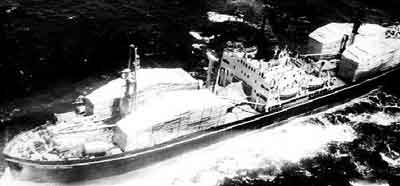
A Soviet freighter carrying missiles to Cuba. Photo from 1962.
On short notice, peacetime exercises could be interrupted by an increased alert. This happened in the Hungarian and Suez crises (1956), the Cuba crisis (1962), the Six-Day war (1967), and the spring crisis in Prague (1968).
New naval bases
Since the birth of the navy, its main base had always been in Copenhagen.
In connection with the expansion of NATO's infrastructure, reinforcement and depot facilities, the need for more naval bases on Danish territory arose.
Therefore, at the end of the fifties, construction began on new bases in Korsør and Frederikshavn. May 2, 1960 the naval base at KORSØR opened and six months later, on October 2, 1960 the base at FREDERIKSHAVN followed.
There was now an even distribution of bases around the country although Holmen in Copenhagen remained the navy's main naval base.
NATO's standing force
To enforce sovereignty and to display NATO's solidarity, the STANAVFORLANT or Standing Naval Force Atlantic, was created. The force was placed under the command of the Supreme Allied Commander, Atlantic (SACLANT), headquartered in Norfolk, Virginia, USA.
In 1970, the Danish frigate PEDER SKRAM became the first Danish unit to operate in STANAVFORLANT. The force normally consists of six to eight destroyers supplemented on occasion with submarines. The vessels came from the NATO countries that commonly operates in the Atlantic.
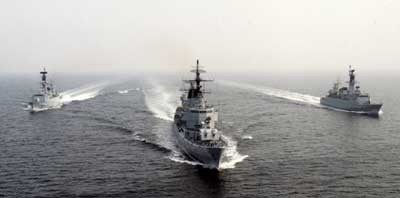
Danish frigates and corvettes have alternated
in operating in STANAVFORLANT.
From the left: the corvette
OLFERT FISCHER, the frigate
PEDER SKRAM and the corvette
NIELS JUEL.
(Photo: Archives of the Royal
Danish Naval Museum)
Subsequently, the frigate HERLUF TROLLE operated in STANAVFORLANT.
From October 1972 to December 1972, the submarine DELFINEN became the first submarine ever to operate in NATO's Standing Naval Force Atlantic.
Later, other Danish submarines have participated in STANAVFORLANT just as the frigates were replaced by corvettes of the NIELS JUEL class.
The beginning of the missile era
Halfway into the 1970's – a good one hundred years after the change from muzzle loaded to breech loaded cannon, the Danish navy entered the missile age.
In 1978, the missile torpedo boat NORBY became the first vessel to be equipped with HARPOON SSM-missiles. The missiles are standard armament for torpedo boats of the WILLEMOES class.
The HARPOON SSM-missiles were installed on frigates of the PEDER SKRAM class in a planned modification in 1979-80. Further, the frigates were also the first Danish units to be armed with SEASPARROW SAM-missiles.
Introducing missiles in the navy was not without problems; on September 6, 1982, the frigate PEDER SKRAM, under the command of Commander s.g. Jens L. Winther, launched by mistake, a HARPOON missile.
The missile hit an area with summer cottages near Lumsås. Luckily, no one was injured in the incident, although it did have heavy coverage in the Danish press.
Epilogue
For many, the fall of the Berlin Wall in November 1989, and the dissolution of the Soviet Union marked the end of the Cold War.
The fact is, however, that since 1949, Denmark's security politics – and through these the navy's tasks – have been based on the country’s membership of NATO. That is how it was during the Cold War, and it will probably remain so for many years.
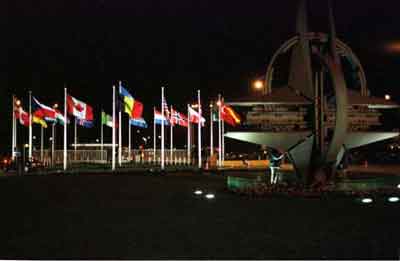
The bastion of flags with Dannebrog (the Danish
flag) to the far left in the circle.
In the foreground, the monument in front of NATO’s headquarters in Bruxelles.
(Photo:
NATO)
|
Sources: |
||
|
& |
Flåden gennem 450 år, by Steen R. Steensen, Martins Forlag, 2nd edition, Copenhagen, 1970 (ISBN 87-566-0009-7) |
|
|
& |
Flådestrategier og nordisk sikkerhedspolitik, Vol. I & II, Det Sikkerheds- og Nedrustningspolitiske udvalg, Copenhagen 1986 (ISBN 87-503-6081-7) |
|
|
44You are also referred to the Naval Bibliography |
||
![]()
- Do you miss a major event on this Site,
or do you hold a great story?
Are you able to contribute to the unfolding of
the Danish Naval History,
please
e-mail
me, enclosures are welcome.
Please remember to list your sources.
You can also use the Naval Web Forum on this web-site.
![]()
|
MORE IN-DEPTH STORIES FROM |
|
The Explosion in Flensburg (1945) - Kieler Expeditionary Force (1945) - JUTLANDIA in Korea - Somebody just had to do it - NARHVALEN reported missing in the Skagerrak (1970) - The Battle off Gedser (1980) - Missile Incident at Lumsaas (1982) |
|
THE TOPIC STORIES: |
|
- Wars against England (1801-1814) - Reconstructing the Navy (1814-1848) - The 1st Schleswig War (1848-50) - The interim War Years (1850-64) - The 2nd Schleswig War (1864) - The long Period of Peace (1864-1914) - The Navy during the 1st World War (1914-1918) - The Interim Years (1919-1939) - The Navy during the 2nd World War (1939-1945) - The Cold War Period (1945-1989) - |
|
SEE ALSO: |
-
This page was last updated: -
This page was first published: February 25, 2006
Copyright © 2013-2016 Johnny E. Balsved - All rights reserved - Privacy Policy

_fra_UFS.jpg)
-297-197.jpg)
